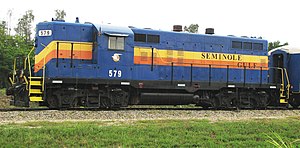EMD GP9
| EMD series GP9 | |
|---|---|
|
EMD GP9 of the Seminole Gulf Railway
|
|
| Numbering: | various railway companies |
| Manufacturer: | Electro-Motive Division |
| Year of construction (s): | 1954-1963 |
| Axis formula : | Bo'Bo ' |
| Gauge : | 1435 mm ( standard gauge ) |
| Length over buffers: | 15,544 mm |
| Service mass: | 110 t |
| Top speed: | 110 km / h |
| Hourly output : | 1,300 kW |
| Motor type: | EMD 567 C, 2-stroke diesel |
| Power transmission: | electric |
| Number of traction motors: | 4th |
The EMD GP9 is a series of four-axle diesel-electric locomotives from the US locomotive manufacturer General Motors Electro-Motive Division (EMD). Originally designed as freight locomotives , some examples were also used for passenger transport.
A total of 4,092 machines with a driver's cab (A-units) and 165 B-units without a driver's cab were built, mainly for US, Canadian and Mexican railroad companies . However, some copies have also been ordered by railways in Brazil , Peru and Venezuela .
development
In 1954 EMD introduced a new generation of its locomotives. The main difference was in the use of the new EMD 567 C motor , which could be operated at a speed of 835 revolutions per minute - thus 35 revolutions per minute faster than the previous type. This enabled the machines to perform better. At the same time, the manufacturer solved the problems with the coolant circuit with the new engine type. The predecessors had frequent leaks. Furthermore, the electrical equipment was adapted to the higher engine power.
construction
Technically, the GP9 was based on the F9 . Changes mainly affected the shape of the locomotive body . According to the slogan Form follows function published by chief engineer Dick Dillworth during the development of the GP7 , a machine was created that did not, as Dillworth put it, Christmas tree decorations and other nonsense (English: "Christmas tree ornaments and other whimsy "). This resulted in lower production costs compared to the EMD F series .
The EMD GP9 had a stable frame, which was covered with doors. This created a very maintenance-friendly design, as all units were easily accessible from the outside. The A units had a driver's cab with which the machines could be driven in both directions, in contrast to the E and F series . Behind it was the engine room with the traction generator , which supplied the direct current for the traction motors, and the diesel engine EMD 567 C. The type designation EMD 567 means that the engine had a displacement per cylinder of 567 cubic inches. The vehicles of the early GP series had 16- cylinder engines. The fuel tank was arranged between the bogies and held 4,542 liters of diesel oil . The air reservoir for the brake was mounted behind it .
A walkway for the shunter was arranged along both sides of the engine casing. This enabled him to get directly from the driver's cab to both ends of the vehicle.
equipment

At the customer's request, the machines were delivered with additional equipment. Many models were delivered with a drag brake. The drive motors convert the kinetic energy into electrical energy and use this to generate heat via braking resistors . As a result, brake wear could be reduced, since the drag brake works without wear. The locomotives equipped in this way had an additional roof fan with a diameter of 48 "(1,219 mm) to dissipate the heat into the environment.
Some machines were equipped with an additional boiler for train heating . This made it possible to use it in front of passenger trains. In the machines with a heating system, the boiler was built into the short front end. This can be seen from the additional exhaust system.
Some of the railway companies that used their GP9 exclusively for freight transport ordered the machines with a low, short hood. This has significantly improved the clarity towards the front. The differences can be seen in the photos.
Whereabouts

Several machines have been preserved in various museums and as a locomotive monument. The series is very popular with shortline railway companies and continues to be used by many smaller railway companies. Even some large companies like the Canadian Pacific Railway still use them as shunting locomotives.
The Western Pacific Railroad Museum in Portola houses three copies: Western Pacific Railroad 725 and 731 and Southern Pacific Railroad 2873. The latter is still in the color scheme as it was intended for the merger of the Southern Pacific and Santa Fe .
swell
- ↑ Solomon, Brian; EMD early road switchers GP7-GP20 locomotives; special publishing North Branch, MN; 1st edition 2006: ISBN 1-58007-096-5 ; P. 40 f.
- ^ 'Schneider, Paul D .; GM's Geeps The General Purpose Diesels, Kalmbach Publishing Co. Milwaukee, 1st edition 2001: ISBN 0-89024-573-8 , p. 7
literature
- Solomon, Brian; EMD early road switchers GP7-GP20 locomotives; special publishing North Branch, MN; 1st edition 2006: ISBN 1-58007-096-5
- Pinkepank, Jerry A .; The Second Diesel Spotters Guide; Kalmbach Publishing Co. Milwaukee; 4th edition 1980; ISBN 0-89024-026-4
- Schneider, Paul D .; GM's Geeps The General Purpose Diesels, Kalmbach Publishing Co. Milwaukee, 1st edition 2001: ISBN 0-89024-573-8
